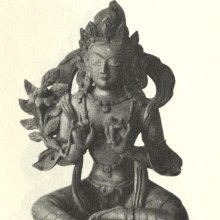Cittavashita, Cittavaśitā, Citta-vashita: 2 definitions
Introduction:
Cittavashita means something in Buddhism, Pali. If you want to know the exact meaning, history, etymology or English translation of this term then check out the descriptions on this page. Add your comment or reference to a book if you want to contribute to this summary article.
The Sanskrit term Cittavaśitā can be transliterated into English as Cittavasita or Cittavashita, using the IAST transliteration scheme (?).
Alternative spellings of this word include Chittavashita.
Images (photo gallery)
In Buddhism
Tibetan Buddhism (Vajrayana or tantric Buddhism)
Source: archive.org: The Indian Buddhist IconographyCittavaśitā (चित्तवशिता) refers to one of twelve Vaśitā Goddesses, as commonly depicted in Buddhist Iconography, and mentioned in the 11th-century Niṣpannayogāvalī of Mahāpaṇḍita Abhayākara.—Her Colour is white; her Symbol is a vajra; she has two arms.
Cittavaśitā is described in the Niṣpannayogāvalī (dharmadhātuvāgīśvara-maṇḍala) as follows:—
“Cittavaśitā is white in colour and holds in her left hand the red vajra with five thongs”.
[These Vaśitās are collectively taken to be the spiritual daughters of the Dhyāni Buddha Amitābha. The twelve Vaśitā Goddesses [viz., Cittavaśitā] are described collectively as two-armed, holding in their right hands the lotus and in the left proudly bearing their special symbols.]

Tibetan Buddhism includes schools such as Nyingma, Kadampa, Kagyu and Gelug. Their primary canon of literature is divided in two broad categories: The Kangyur, which consists of Buddha’s words, and the Tengyur, which includes commentaries from various sources. Esotericism and tantra techniques (vajrayāna) are collected indepently.
General definition (in Buddhism)
Source: Wisdom Library: Dharma-samgrahaCittavaśitā (चित्तवशिता) or simply Citta refers to the “mastery of mind” and represents one of the “ten masteries of the Bodhisattvas” (vaśitā) as defined in the Dharma-saṃgraha (section 74). The Dharma-samgraha (Dharmasangraha) is an extensive glossary of Buddhist technical terms in Sanskrit (e.g., citta-vaśitā). The work is attributed to Nagarguna who lived around the 2nd century A.D.
See also (Relevant definitions)
Partial matches: Vasita, Citta.
Full-text: Vasita, Citta, Ten Masteries.
Relevant text
No search results for Cittavashita, Cittavaśitā, Citta-vashita, Citta-vaśitā, Citta-vasita, Cittavasita; (plurals include: Cittavashitas, Cittavaśitās, vashitas, vaśitās, vasitas, Cittavasitas) in any book or story.

